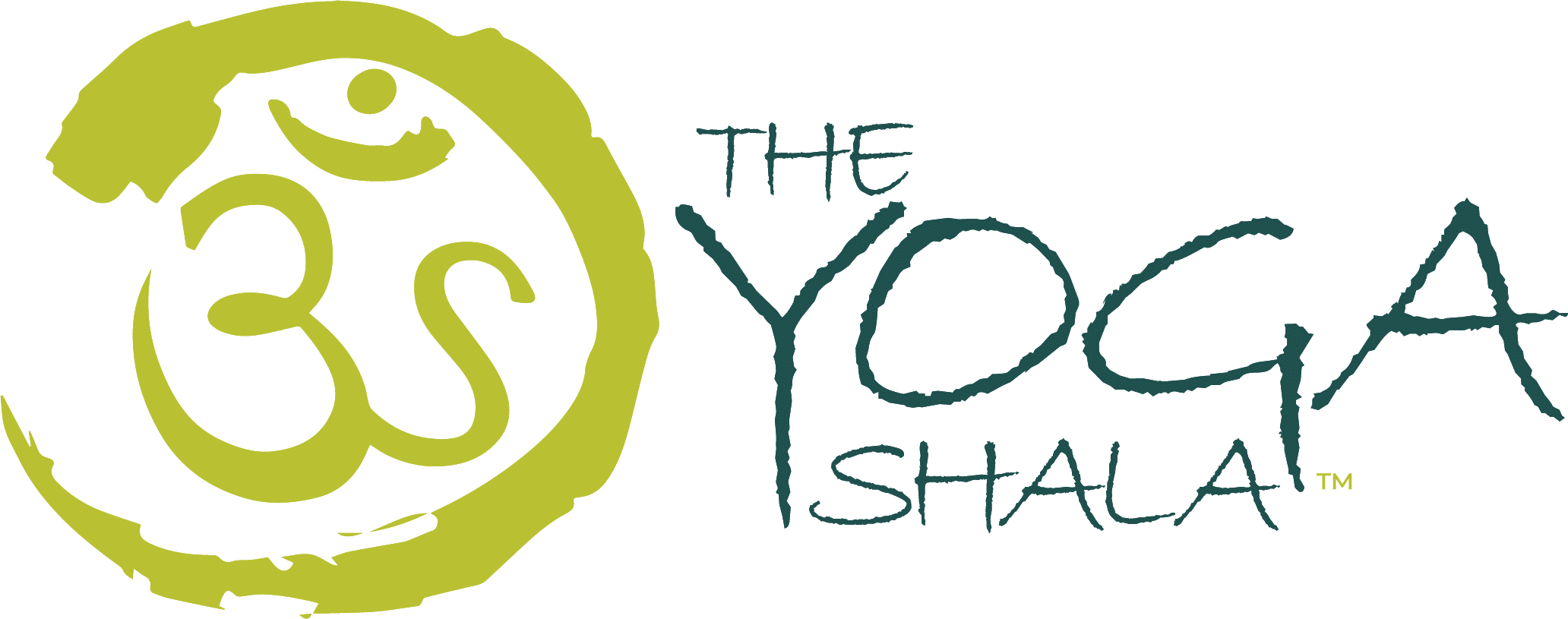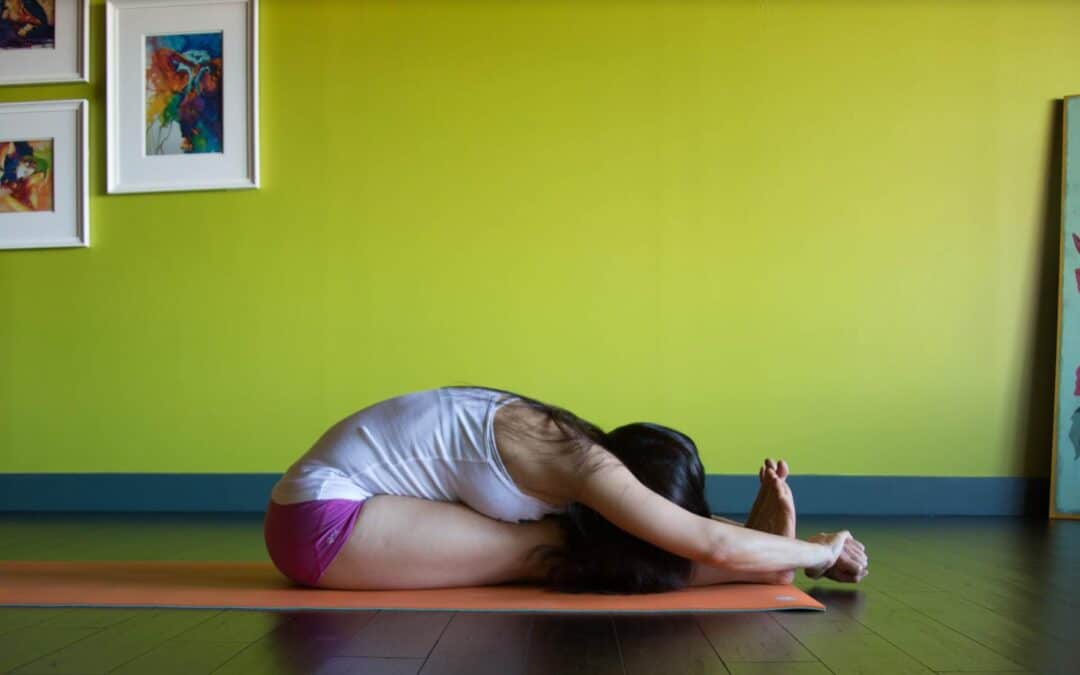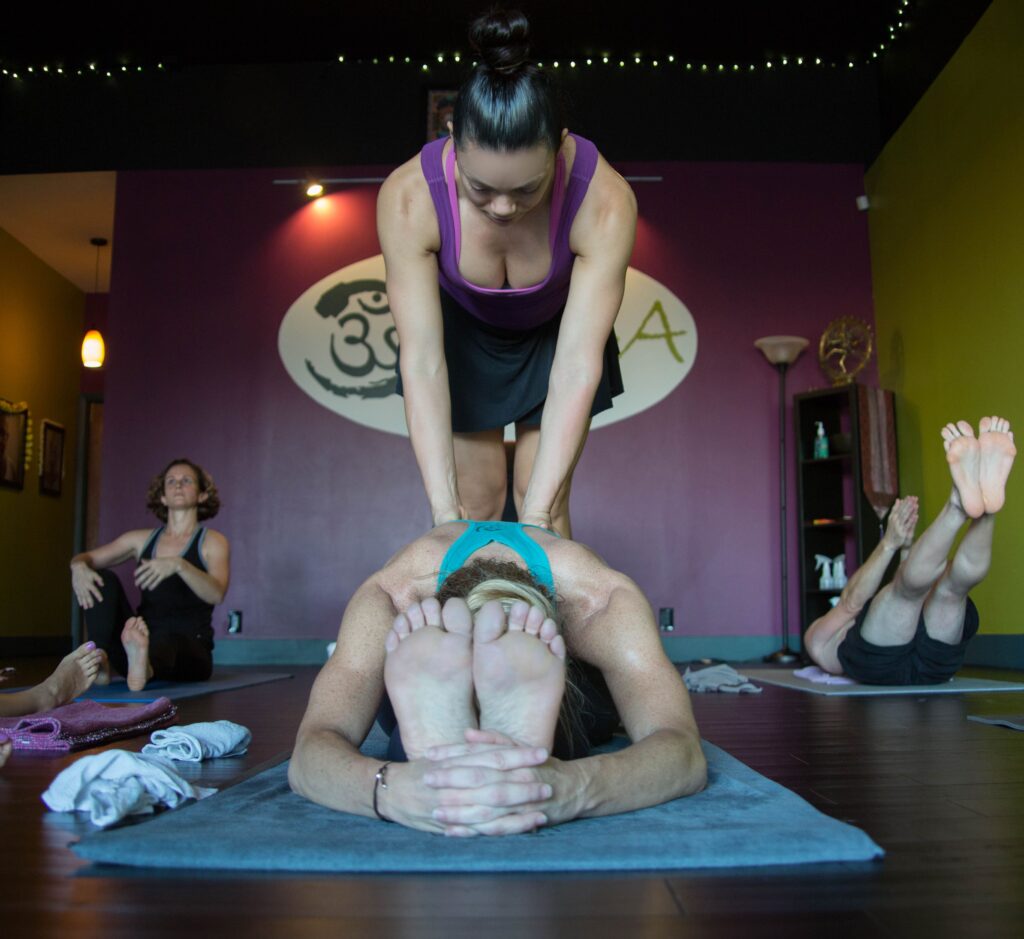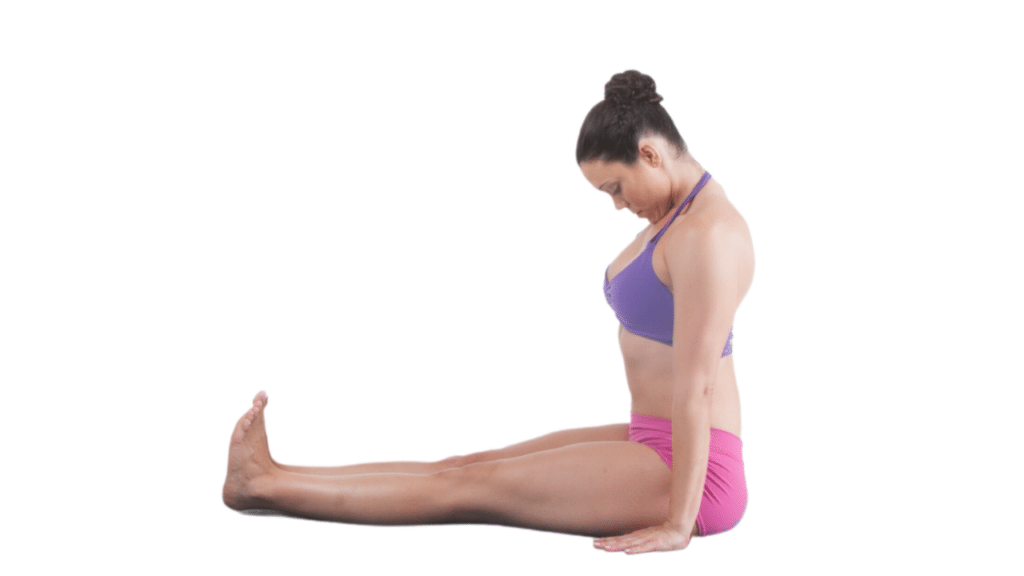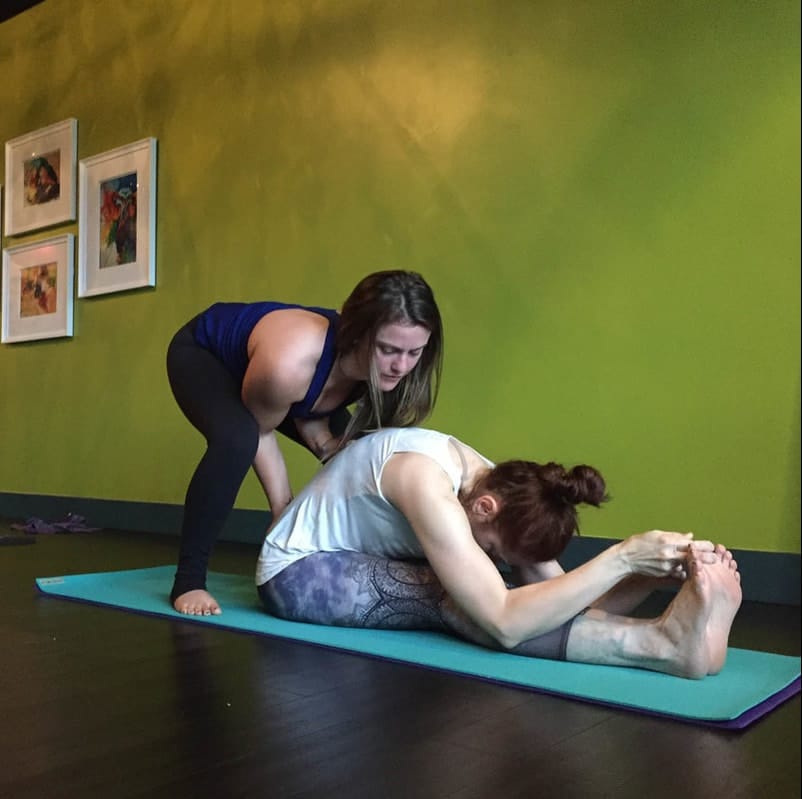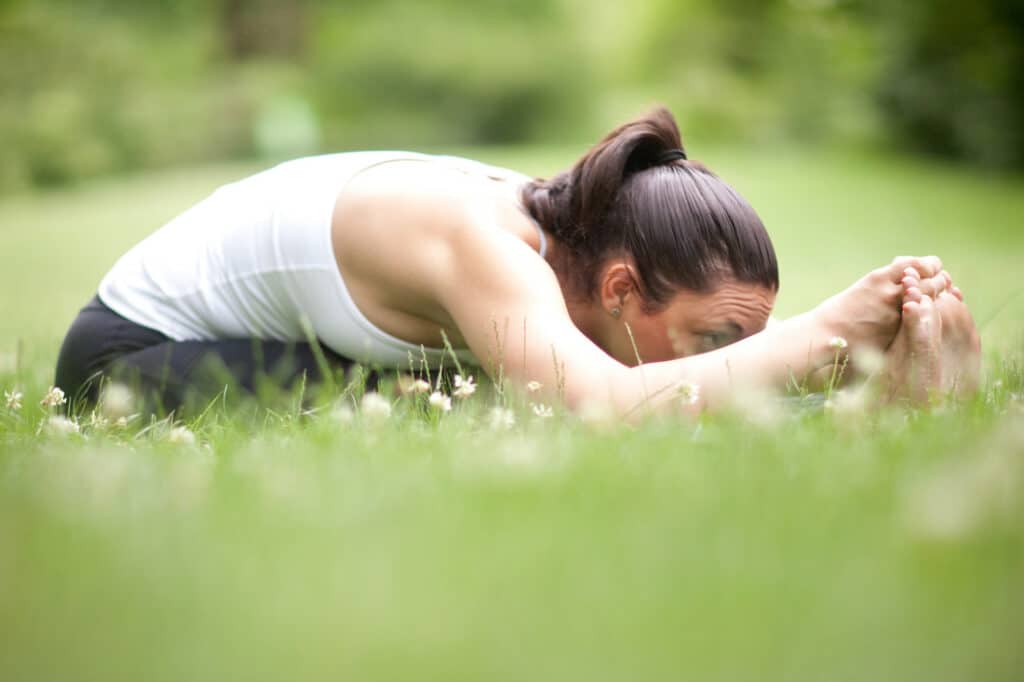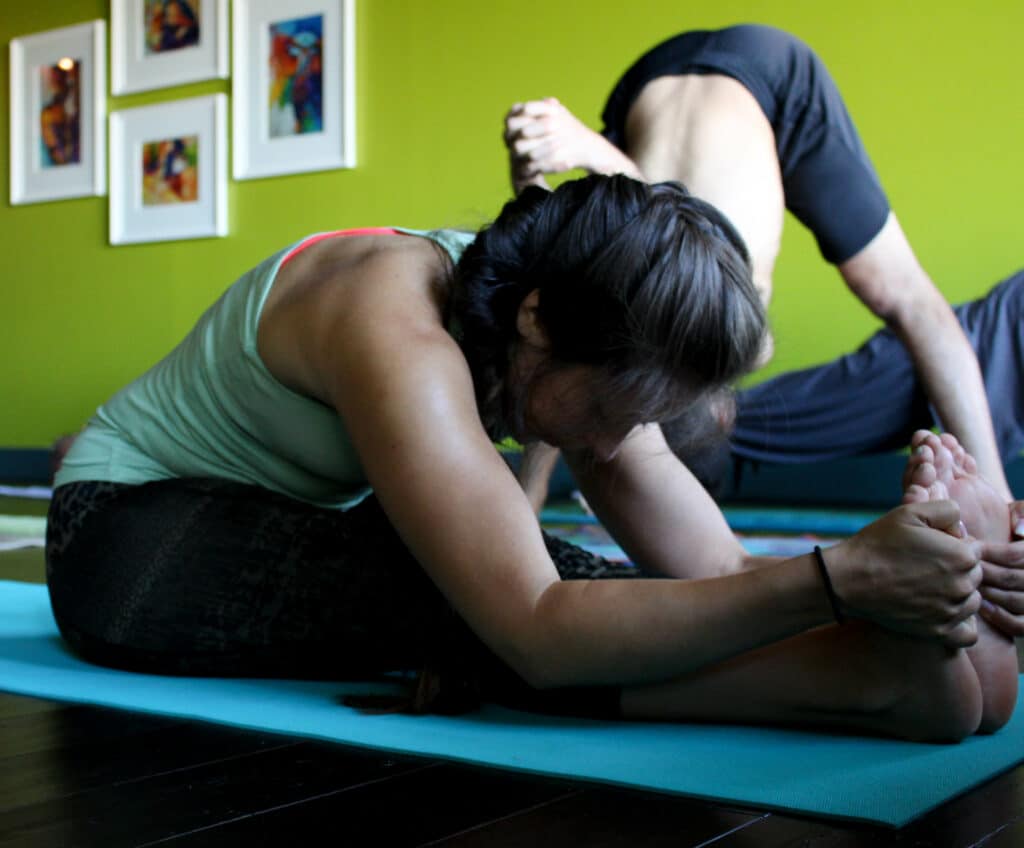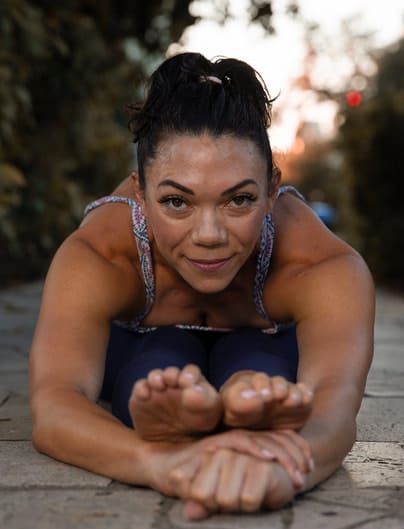Ashtanga Yoga, a dynamic and traditional yoga practice, is revered for its structured series of postures that synchronize breath and movement. One of the foundational poses in this system is Dandasana, also known as Staff Pose. This is the first seated posture of the Ashtanga Yoga Primary Series. In this blog post, we’ll look at both Dandasana and Paschimottanasana and learn how to practice it with the Sanskrit Vinyasa Count, which adds a touch of authenticity and depth to your practice.
Understanding Dandasana & Paschimottanasana
Dandasana and Paschimottanasna serve as a building block for many other asanas in the Ashtanga Yoga series. These poses may appear simple, but they require precision and engagement of various muscle groups.
Benefits of Dandasana & Paschimottanasana
Improved Posture:
Dandasana encourages you to sit with a straight spine and an upright posture. This alignment helps in strengthening the muscles of the back, shoulders, and core, promoting better overall posture. Regular practice Paschimottanasana helps correct rounded shoulders and hunched posture by opening and elongating the spine. It encourages the natural curvature of the spine, promoting better alignment.
Core Strength:
Engaging the muscles of the abdomen and lower back is essential to maintain the pose correctly. Regular practice of Dandasana helps to tone and strengthen the core muscles, providing stability and support to your spine.
Hamstring Flexibility:
In Dandasana, your legs are extended straight in front of you. This stretches the hamstrings (the muscles at the back of your thighs) and helps to improve their flexibility over time. Flexible hamstrings can alleviate lower back tension and reduce the risk of injuries. Paschimottanasana targets the hamstrings and lower back, gradually increasing flexibility in these areas. As you deepen your forward fold over time, you’ll notice improved range of motion in the hips and hamstrings.
Enhanced Spinal Health:
The elongation of the spine in Dandasana promotes healthy spinal alignment and decompression. It helps to counteract the negative effects of slouching, which can lead to discomfort and spinal issues.
Improved Digestion:
Sitting in Dandasana & Paschimottanasana encourages an open chest and an elongated torso. This can aid in improving digestion by allowing more space for your internal organs and facilitating better digestion and elimination. And the forward fold in Paschimottanasana compresses the abdominal region, stimulating the digestive organs. This can help improve digestion, alleviate constipation, and enhance overall gut health.
Energy Flow:
Practicing Dandasana helps to stimulate the flow of energy (prana) in your body. When the spine is aligned and the breath is regulated, the energy channels (nadis) are believed to open up, creating a balanced and harmonious flow of energy throughout the body. While Paschimottanasana is associated with stimulating the Svadhisthana (sacral) and Manipura (solar plexus) chakras, which are believed to influence creativity, self-confidence, and willpower.
Calmness, Grounding and Focus:
Dandasana is a seated posture that lends itself well to meditation and introspection. As you sit with an attentive presence, focusing on your breath and alignment, you can experience a sense of calmness and increased mental clarity. The act of folding forward creates a sense of introspection and introspective focus. Paschimottanasana encourages turning inward and cultivating a sense of grounding and presence.
Preparation for Other Asanas:
Dandasana serves as a foundational pose for more advanced asanas. Proper alignment and engagement in Dandasana help prepare the body for poses that require similar principles, such as seated forward bends and inversions. And regular practice of Paschimottanasana prepares the body for more advanced forward folds and seated poses in the Ashtanga Yoga sequence.
Mind-Body Connection:
The practice of Dandasana and Paschimottanasana encourage a mindful connection between your breath and movement. The focused awareness required during the pose enhances your mind-body connection, promoting a sense of presence and self-awareness.
Relaxation and Stress Relief:
Although Dandasana requires effort, it is a relatively calm and grounding pose. The combination of steady breathing and physical alignment can promote relaxation and alleviate stress and tension. And Paschimottanasana is often recommended for relieving symptoms of menstrual discomfort, as it can soothe abdominal cramps and lower back pain.
Stretching the Back Body & Releasing Lower Back Tension:
Paschimottanasana provides a deep stretch to the entire back body, including the spine, hamstrings, calves, and the muscles along the spine. This elongation helps release tension and improve flexibility in these areas. For individuals with lower back discomfort, Paschimottanasana can offer relief by gently stretching the muscles in the lower back and promoting relaxation in that area.
Massaging Internal Organs:
The compression of the abdomen in the forward fold massages the internal organs, promoting detoxification, improved blood circulation, and the optimal functioning of organs.
Incorporating Dandasana and Paschimottanasana into your yoga practice, especially within the context of the Ashtanga Yoga system, can provide you with a solid foundation for your journey toward physical strength, flexibility, and inner harmony. Remember that consistency is key – the benefits of these postures become more pronounced as you integrate them into your routine over time.
Click here to watch a Yoga tutorial breaking down Dandasana and Paschimottanasana
Contraindications
Back Injuries or Conditions:
If you have a recent or chronic back injury, herniated disc, or any other spinal condition, practicing these postures might exacerbate your condition. Always consult with a medical professional before attempting this pose, and consider modifying or skipping it if it causes discomfort.
Hamstring Injuries:
Dandasana and Paschimottanasana involves stretching the hamstrings. If you have a hamstring injury, be cautious when extending your legs straight. Modify the pose by bending your knees slightly.
Knee Issues:
If you have knee problems, such as injuries, discomfort, or limited flexibility, practicing Dandasana or Pacchimottanasana with legs extended might strain the knees. Keep your knees slightly bent to prevent strain on the knees.
Sciatica:
Sciatica refers to pain that radiates along the path of the sciatic nerve, typically affecting the lower back, buttocks, and legs. Dandasana’s forward fold can compress the sciatic nerve, potentially worsening the condition. Consult a healthcare professional before attempting this pose if you have sciatica.
Pregnancy:
As your body changes during pregnancy, Dandasana might become uncomfortable due to the pressure on your abdomen and pelvis. Consider practicing a modified version with support under your hips or avoid the pose if it causes discomfort.
Hip or Groin Injuries:
If you have a history of hip or groin injuries, be cautious when practicing Dandasana. The external rotation of the hips required for the pose might strain these areas. Use props and modify the pose to suit your comfort level.
High Blood Pressure:
If you have high blood pressure, the seated position in Dandasana might not be advisable for extended periods. Instead, consider practicing the pose with your back against a wall. Paschimottanasana involves a forward fold that can temporarily increase blood pressure. Individuals with high blood pressure should approach the pose mindfully and avoid excessive compression of the abdomen. Avoid holding the pose for an extended period and come out of it immediately if you feel any discomfort.
Recent Abdominal Surgery:
If you’ve had abdominal surgery, Dandasana might place undue pressure on your healing abdominal area. Avoid straining or compressing the area until you’ve fully healed. And it’s best to avoid Paschimottanasana until you have fully healed and received clearance from your healthcare provider.
Osteoporosis:
Individuals with osteoporosis should approach Dandasana and Paschimottanasana cautiously, especially if there’s a risk of vertebral compression fractures. Avoid rounding the spine excessively.
General Discomfort:
If you experience discomfort or pain while attempting Dandasana, listen to your body. It’s important not to force yourself into the pose. Modify the pose or skip it altogether if it doesn’t feel right for you.
Remember that yoga should be practiced mindfully and with respect for your body’s limitations. If you have any underlying health conditions or concerns, it’s always a good idea to consult a healthcare professional before starting a new yoga practice or attempting specific poses like Dandasana or Paschimottanasana. An experienced yoga teacher can also guide you through modifications or alternatives that suit your individual needs.
Sanskrit Vinyasa Count: Adding a Traditional Dimension
In Ashtanga Yoga, the practice is guided by a specific counting method in Sanskrit, which directs both the breath and the movement. This precise system enhances the meditative aspect of the practice, creating a seamless flow of energy and consciousness.
Benefits of Practicing Dandasana and Paschimottanasana with Sanskrit Vinyasa Count
Practicing Dandasana with the Sanskrit Vinyasa Count enhances your connection to the ancient roots of Ashtanga Yoga. The rhythmic counting and synchronized breath allow you to cultivate mindfulness, fostering a deeper mind-body connection. Additionally, the specific cues offered by the Sanskrit count help you refine your alignment and experience the pose more profoundly.
Step by Step Instructions for practicing Dandasana and Paschimottanasana using the Sanskrit Vinyasa Count:
Sapta (Vinyasa #7): From Adho Mukha Svanasana (down dog), look forward and walk or jump your feet through and have a seat on the floor with your legs extended in front of you. Flex your feet, engaging the quadriceps and pressing your heels forward as you press your tailbone backward. Place your palms on the floor beside your hips, fingers pointing forward. Bring your chin to your chest and look toward your nose (nasagrai drishti).
Take five deep breaths here.
As you breathe in, elongate your spine, lifting your chest slightly. This action should come from your core, not your lower back.
Asthau (Vinyasa #8) Inhale and lengthen your spine. Head up. Grab your grab your big toes with your thumb, index finger and middle fingers.
Nava (Vinyasa #9) Exhale and fold forward. Flex your feet, engage your quadriceps, and hinge at your hips to fold forward from the hips. Look towards your toes (Padhayoragrai drishti
Take five deep breaths.
Dasa (Vinyasa #10) Inhale – lift your head and torso up.
Nava (Vinyasa #9) Exhale – grab the outside of your feet with your hands (or bind your hands) and fold forward.
Take five deep breaths
Dasa (Vinyasa #10) Inhale – lift your head and torso up. Exhale there.
Ekadasa (Vinyasa #11) – On your inhale, bring your hands to the floor, cross your legs and lift your body up off the ground.
Dvadasa (Vinyasa #12) – Exhale and jump back into Chaturanga Dandasana.
Trayodasa (Vinyasa #13)- Inhale into Urdhva Mukha Svanasana(Upward facing dog)
Caturdasa (Vinyasa #14) – Exhale into Adho Mukha Svanasana (Downward facing dog)
Click here to watch a Yoga tutorial breaking down Dandasana and Paschimottanasana
Practicing Paschimottanasana with the traditional Sanskrit vinyasa count provides a deeper connection between your breath and movement, enhancing the benefits of this pose. Remember that yoga is a journey, and it’s important to honor your body’s limitations while gradually working towards greater flexibility and awareness. As you integrate the Sanskrit vinyasa count into your practice, you’ll find a meditative flow that not only nurtures your physical body but also calms your mind and uplifts your spirit. So unroll your mat, follow the steps, and embrace the transformative journey of Ashtanga Yoga and Paschimottanasana.
Modifications
If you have tightness in certain areas or are working through an injury or illness, modifying Dandasana (Staff Pose) can make the pose more accessible and comfortable. Here are some modifications you can try:
Bend Your Knees:
If you have tight hamstrings, consider bending your knees slightly. This modification reduces the intensity of the hamstring stretch and can make the pose more comfortable. Gradually work on straightening your legs over time as your flexibility improves. For now focus on gently pressing your heel forward and your tailbone backwards through space to create extension through your spine. Do NOT try to straighten your leg by pressing your knee downward. Instead, ground through your sitzbones and press your heel forwards. Work with your breathe and bandhas.
Wall Support:
If you have tightness in your back or difficulty sitting upright, practice Dandasana & Paschimottanasana against a wall. Sit with your back against the wall and your legs extended in front of you. The wall provides gentle support, helping you maintain an aligned spine.
Chair Modification:
For individuals with significant tightness in the hamstrings or back, you can practice a seated version of Dandasana and Paschimottanasana on a chair. Sit at the edge of the chair, extend your legs in front of you, and place your hands on the seat or armrests. This reduces the intensity of the stretch while still allowing you to benefit from the pose. Similarly, for Paschimottanasana, sit on the edge of a chair, feet flat on the floor. Hinge at the hips and fold forward, resting your forearms or hands on your thighs. This seated modification minimizes strain on the hamstrings.
Practice Mindful Breathing:
Regardless of the modifications you choose, focus on your breath and the alignment of your spine. Mindful breathing can help you relax into the pose and release tension in your back and hamstrings over time.
Shoulder Mobility Variation:
If you have tight shoulders or limited mobility in your upper body, you can practice Dandasana with your hands placed slightly behind your hips and fingers pointing forward. This variation allows you to maintain an upright spine while providing a more comfortable arm position.
Modifications in yoga are not a sign of weakness; they are tools that empower you to practice safely and with respect for your body’s needs. Paschimottanasana can be adapted in various ways to accommodate your individual circumstances. Listen to your body, make use of props, and always prioritize comfort and alignment. With consistent practice and patience, you’ll gradually discover the benefits of this pose, regardless of your current level of flexibility.
Click here to watch a Yoga tutorial breaking down Dandasana and Paschimottanasana
Practice with The Yoga Shala
If you want to join us for LIVE classes, The Yoga Shala offers virtual and in person classes every weekday morning. We are located at 140 Circle Drive, #4, Maitland, Florida. Owner, Krista Shirley, also offers virtual or in person private sessions (Yoga, Meditation, Breath-work, Nutrition, Life Coaching and Mentorship). Visit theyogashala.com for details.
Be sure to signup for our newsletter to stay on top of local events and classes, Nysa products sales, new offerings, new products and more!
We hope you find this video series helpful to you in creating or maintaining your yoga practice!
About Krista
Krista Shirley is a level II authorized Ashtanga Yoga teacher. She is deeply passionate about sharing these teachings with all who wish to learn.
If you want to join Krista in person she teaches daily classes at The Yoga Shala in Maitland, Florida. She also offers virtual sessions in Yoga, Meditation, Breath-work, Nutrition, Life Coaching and Mentorship. Check out www.theyogashala.com for more details.
If you do not live in Central Florida and want to find an authorized teacher in your area, check out our teacher, Sharath Jois’ website, for a list of all teachers authorized and certified by his yoga centre in India.
|
|
|
|
|
❤️SHOP MERCHANDISE: Nysa Products
❤️LET’S BE SOCIAL:
Instagram: Krista Shirley Yoga
Instagram: The Yoga Shala
Facebook: The Yoga Shala
Facebook: KristaShirleyYoga
For other inquires please contact: [email protected]
